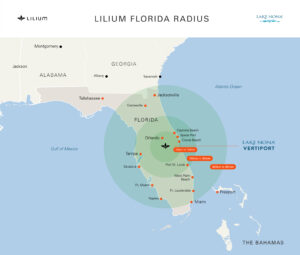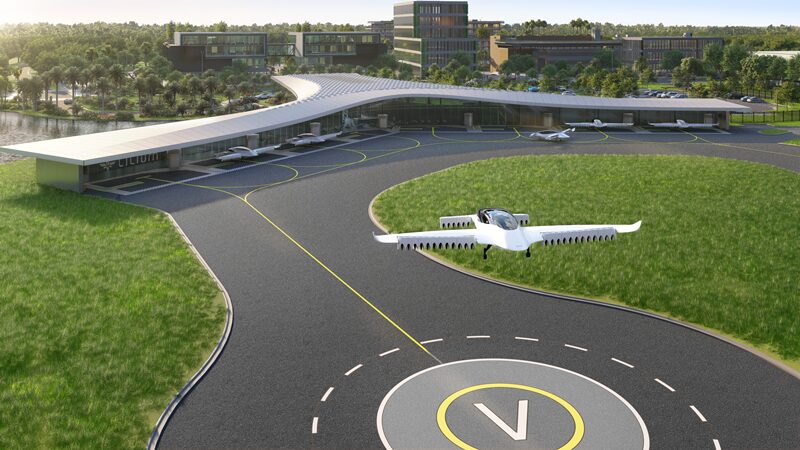Two radical-looking electric aircraft, both quiet flyers, contrast in flight modes – eVTOL (electric Vertical Take Off and Landing), and eCTOL (electric Conventional Take Off and Landing). Germany’s Lilium and America’s Whisper Jet show their unique ways.
Lilium
Founded in 2015, Lilium, like most of its competitors, is less than a decade old, but already boasts 950 employees in four offices. The workers come from six continents and comprise 58 nationalities, a winner in any Diversity, Equity, and Inclusion ranking. They make an impressive product.

Liliuim’s range on currently available batteries overlaid on a map of Florida. Outer ring would take passenger from Orlando to Miami in about an hour
Lilium is an expensive machine, costing around $7 million plus. Its marketing approach seems to be toward the VIP set and its first locations are in cash-rich areas such as the French Riviera and along Florida’s eastern shoreline. Despite the glossy façade, there’s a solid array of engineering inside.
Batteries
One of the first questions your editor had on early versions of Lilium’s aircraft was where they hid the batteries. Recent news from the company shows they distribute the energy in ten separate packs, “to deliver range for regional air mobility and redundancy.”
Here, Daniel Wiegand, co-founder, CEO and Chief Engineer for Innovation, discusses the use of batteries and the near-future promise of upgrades to that energy source.
Overall Design
The seven-seat LiliumJet eVTOL will carry a pilot and six passengers at cruise speeds up to 250 kilometers per hour (155 mph) at altitudes up to 3,000 meters (10,000 feet). The 3,175 kilogram (7,000 pound) mass will be lifted by 36 electric vectored thrust (DEVT) fans arrayed along the trailed edges of the canard and wing.
Certified as a fixed-wing aircraft, Lilium’s carbon-fiber construction uses its 36 motors for lift, propulsion, and control, with individually articulated fans on the rear wing providing aerodynamic control.
Lilium claims a lift-to-drag ratio equivalent to that of a jet airliner and noise levels “6 to 7 times quieter than a helicopter at take off.” Part of the low drag and lack of noise may come from the things Lilium lacks, listed by the eVTOL Directory as:
- No folding propellers or wings
- No tail
- No rudder
- No propellers
Other elements contribute to simplicity of operation and enhancement of safety:
- No gearboxes
- No tilting wings
- No water cooling
- No liquids (petroleum fuel or oil)
- No single point of failure. (Example of a single point of failure: If an aircraft has one engine [such as a Cessna 150] and that one engine fails, that is a single point of failure.)
Whisper
Whisper Aero seems intent on developing its quiet powerplants, and is looking for an airframer to develop a viable platform for those little motors. Its basic design is a flying wing with outrigger rudder and elevon surfaces that will carry a pilot and nine passengers in a 50-foot span vehicle. Heavier than the Lilium by 5,000 pounds, its electric motors would need to provide sufficient thrust to drive the craft at its promised cruise speed 250 knots (287.5 mph).
Currently, the Whisper web site shows three levels of ducted fan power. The eQ120 has a five-inch diameter fan and can produce five pound force of thrust at a noise level below 35 dB. The eQ160 produces 10 pound force of thrust from its six-inch fan at less than 37 dB. Whisper’s largest standard unit, the eQ250, delivers 70+ lbf of thrust from its 10-inch diameter fan.
The smallest fan is used in applications like leaf blowers, making for neighbor-friendly lawn management. eQ160s can be used for small drones, such as the one shown in Whisper’s overflight noise comparison.
Iron Man Checks In
eVTOL News reported, “The company announced that it had raised $7.5M, including from “Iron Man” actor Robert Downey, Jr.’s FootPrint Coalition Ventures. ‘Creating unchecked noise pollution for the sake of electric aviation’s vital future is a problem,’ Downey said in a statement.” Toward the desirable end of reducing noise pollution, the solution may end up looking like the proposed design shown in this video.
Pitching to a Hometown Audience
Dr. Mark Moore, former NASA and Uber Elevate leader, tells a gathering in Crossville, Tennessee about the aspirations of his new firm. He not only makes a case for his company, but for regional air transit.
What’s Next?
Seeing these two enterprises presenting highly original approaches to an already packed market, we hope for their success. Both are backed by enthusiastic founders and innovative approaches and engineering. Both promise solutions to our noisy urban environments. Both can achieve relatively low cost interurban aerial transport at an initial regional level. We can hope for their success because they will benefit us all.

